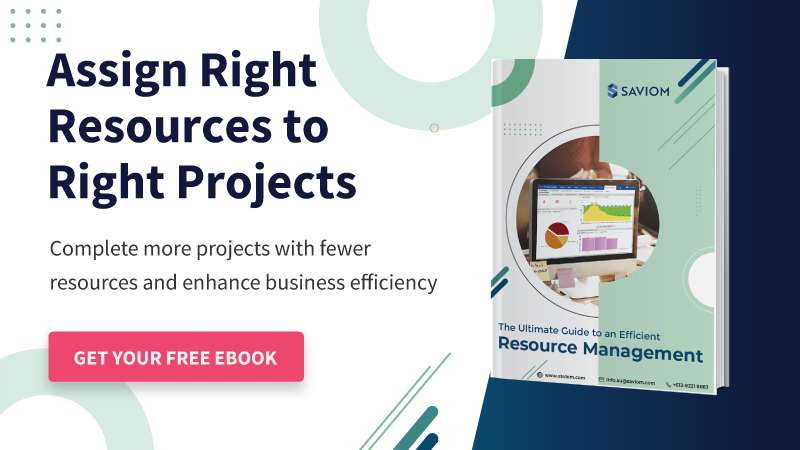How can an organization maintain a healthy resource index, ensure project quality, and minimize costs?
Resource optimization is the ideal technique or strategy to do so. From preventing over or underutilization of the workforce to reducing resource costs and ensuring competent allocation to enhancing profit margins, this strategy can help elevate overall business efficiency.
Further, this approach helps businesses build an optimized future-ready workforce and tap into their maximum potential to maintain a healthy resource health index.
This article highlights the essential aspects and best practices of resource optimization in project management.
Let’s begin by understanding the definition of resource optimization.
What is Resource Optimization?
Resource optimization is a management practice or strategy to boost employee performance, efficiency, and productivity within a project-based organization.
Resource optimization in project management comprises various processes such as planning, forecasting, allocating, scheduling available resources, and utilizing them intelligently to meet the organization’s objectives. These resources can be human, equipment, facilities, finance, etc.
The ultimate goal of a resource optimization strategy is to improve the employees’ productivity and improve business profitability by ensuring smooth project execution.
Now, let’s read about the various resource optimization types.
What Are the Different Types of Resource Optimization?
Resources can be optimized at different levels, such as capability, cost, utilization, location, and season, to ensure profitability and successful project delivery.
Let’s look at each one of the resource optimization techniques in detail.
Capability Optimization
According to Gallup, “Utilizing the skills and strengths of employees regularly improves their engagement by six times.”
The focal point of capability optimization is allocating resources to appropriate tasks. In other words, allocation optimization pertains to fulfilling every skill and competency requirement of the projects, bridging an existing capacity gap.
Capability optimization encapsulates various resourcing treatments such as retraining/upskilling, hiring, or implementing an out-rotation/backfill strategy. Additionally, it helps avoid allocating over or under-skilled employees to projects, ensuring successful project delivery and boosting profitability.
Cost Optimization
After estimating the resources required, the project budget is analyzed, and the cost-effective employees are identified across the organization. This also includes forming an appropriate resource mix of permanent and on-demand employees to avoid cost escalations.
Further, resources are allocated proactively to prevent last-minute firefighting and billing loss. All these processes constitute resource cost optimization. It facilitates managers in procuring resources with the right experience level and cost to control the project’s financials and ensure timely delivery within budget.
Utilization Optimization
Utilization optimization prevents managers from over or underutilizing resources and ascertains uniform workload distribution. Hence, before assigning tasks, managers can view the resources’ schedules, understand their availability, and book accordingly.
If a resource is overbooked, they can apply techniques such as leveling and smoothing to prevent burnout. On the contrary, if the talent pool is underutilized, managers can bring forward project timelines and allocate them accordingly. Further, they can also forecast and mobilize resources from non-billable to billable or strategic work to enhance productivity.
Location Optimization
Location optimization enables managers to hire or allocate resources from suitable locations based on the project’s requirements, keeping the skillset, cost, and other constraints in mind.
It increases in-person interaction between the client and delivery team and creates better coordination as respective personnel can meet at their convenience to discuss issues and find solutions quickly.
Seasonal Optimization
It refers to the strategic allocation of resources to align with the fluctuating demands and trends at different times of the year. For example – the professional services industry has seasonal peaks and troughs when demand and services substantially increase or decrease. During the peak period, the organizations can increase their consultants’ charge-out and employee utilization rates, thereby improving profits for the firms.
During the trough period, the organization can reduce the charge-out rate to attract and retain clients. They can also implement training and upskilling programs to future-proof the workforce. In both situations, managers are well-equipped to increase revenue and promote the employees’ work-life balance, thus minimizing stress and burnout.
Resource managers use different techniques to optimize the workforce and balance their schedules. The following section explains these techniques in detail.
Read More: How can you Implement Workforce Optimization to Improve Productivity?
What are the Different Resource Optimization Techniques?
Organizations implement various resource optimization techniques depending on the nature of a project. Here are the most prominent ones:
Resource Leveling
Resource leveling is implemented on projects with flexible timelines where the start and end dates can be re-adjusted based on the critical resource’s availability and schedule.
For example, suppose a web developer is unavailable to work on a website revamp project before the stipulated deadline. In that case, managers can communicate with the stakeholders and adjust the project timeline. This helps to prevent overallocation and reduces the risk of employee burnout.
Read More: Getting Resource Leveling Right for Projects
Resource Smoothing
Resource smoothing in project management, also known as Time Constrained Scheduling, is used when the project is time-sensitive. If a resource is overwhelmed, managers adjust the float tasks and redistribute the workload or add additional resources without affecting the critical path.
For instance, a project’s float task requires 80 hours, and the resource is allocated 10 hours of work every day. However, since there is room for flexibility, managers can assign the same resource for 8 hours and ten days or schedule a junior resource. This helps ease the employee’s schedule without hampering the deadline.
Reverse Resource Allocation
Reverse resource allocation is usually applied to highly technical projects with a fixed deadline or requires critical/niche skilled resources to perform certain phases of the project on specific dates. Here, managers start scheduling resources for final or critical tasks first, ensuring that the specialized resources are available as planned.
For instance, an IT project requires an expert in cloud computing to undertake a task scheduled between Jan 20th and 28th. So, the manager begins scheduling this resource from this point backward to ensure their availability during the set dates.
Modeling and Simulation
Modeling and simulation is a technique that assists managers in building multiple scenarios in a sandbox environment. They can then analyze and compare the outcomes of each scenario, select the best-fit resource plan, and prioritize projects. It enables them to prevent potential bottlenecks and protect profit margins.
For example, suppose there is a pipeline project with a certain probability of approval. In that case, managers can form different resource mixes, modify the utilization, evaluate the impact on the project’s timeline and budget, and select the best possible outcome before applying it to the actual resource plan.
Critical Path Method (CPM)
CPM is a resource optimization technique that identifies the sequence of crucial tasks and determines the minimum project duration. By mapping tasks and dependencies, this technique helps managers pinpoint the critical path to the longest stretch of dependent activities.
This technique aids in prioritizing activities, managing resource constraints, and maintaining project timelines. For example, in a software development project, CPM identifies coding and testing as critical tasks. Resources are allocated accordingly to ensure timely completion and prevent delays in the product launch.
So far, we have understood the types and techniques of resource optimization. Now, it’s time to know how it benefits the organization.
Why is Resource Optimization Important in Project Management?
Resource optimization improves workforce performance and productivity at the granular level to ensure successful project delivery. It also offers myriad benefits to the organization.
The most prominent ones are listed below:
Reduces Resourcing Costs
As mentioned earlier, resource capability optimization allows one to identify and allocate cost-effective global and skilled junior resources instead of expensive senior resources to control costs. Resource optimization also entails proactively allocating employees and eliminating the last-minute hiring costs.
Facilitates Task Prioritization
Once the managers implement the critical path method in the project planning stage to identify the most critical tasks, they can prioritize them better. Accordingly, managers can schedule or bring in more resources to finish essential tasks first. This ascertains the completion of tasks in chronological order based on urgency.
Read More: How Resource Optimization Boosts Task Management?
Helps Form the Right Mix of Resources
Resource optimization allows organizations to form the right mix of senior and junior resources. This will help reduce the workload of critical resources and enable other resources to diversify their skill set. Moreover, cost optimization helps them form the right blend of contingent and permanent workforce to prevent unnecessary overhead costs.
Enables Competent Resource Allocation
Capability optimization helps avoid assigning over or under-skilled employees to projects. Managers can also leverage the shared services model to allocate inter-departmental resources to suitable projects at the right cost. It allows them to align the project demands with the skillset and maintain quality.
Improves Employee Productivity
By tracking the utilization levels, managers also prevent the risks of employees being under/overutilized. Moreover, they also ascertain that no over or under-skilled employee is working on the given tasks. When employees work on projects that align with their skill set and availability, they will not be stressed or burnt out, eventually boosting their productivity.
Prevents Employee Burnout and Disengagement
Overutilization will result in stress and burnout, and resource underutilization will disengage the employees as their skill set is not appropriately leveraged. By implementing resource utilization optimization, managers ensure the uniform distribution of workload. As a result, it enhances performance and boosts productivity.
Read More: How Workforce Planning Prevents Employee Burnout Down the Line
Builds Transparency in the Workplace
With visibility over current and future resource schedules, managers can track resource availability, capacity, utilization, etc., in real time. This allows stakeholders to closely monitor ongoing projects, measure their progress, and assess whether resources are optimally deployed. Thus, resource optimization enhances operational efficiency and creates a transparent working environment.
Helps Future-proof the Workforce
Organizations can implement training and upskilling programs for resources to diversify the skills. They can technically prepare the resources to take on multi-faceted projects in the upcoming seasons. This helps them future-proof the workforce and maintain a competitive advantage.
Now that the benefits are clear, let’s understand the challenges firms face during resource optimization.
Read More: Importance of skill development in making your workforce future-ready
What Are the Major Resource Optimization Challenges in Project Management?
Resource optimization comes with its fair share of challenges. Some common challenges include:
Resource Constraints
Resource constraints, such as unavailability of niche resources, unplanned attrition, employee absenteeism, etc., can pose a challenge when optimizing their allocation and utilization. This affects the project execution and can derail it off its track. Thus, when resources are scarce, it becomes crucial to prioritize and allocate them effectively to maximize their utilization.
Complex Resource Dependencies
In project-based organizations, resources often have interdependencies, where the optimal allocation of one resource may affect the performance or availability of others. Managing these dependencies and finding the right balance can be challenging. This leads to potential bottlenecks and resource conflicts that hinder project progress and overall organizational performance.
Evolving Project and Resource Requirements
Resource optimization must account for dynamic factors such as changing market demands, technological trends, customer preferences, or project requirements. Adapting resource allocation strategies to meet these evolving needs requires flexibility. However, most firms lack the agility and foresight to manage these changes adequately.
Lack of Real-time Visibility into Resources Attributes
Lack of real-time visibility into resource metrics, such as capacity, availability, utilization, etc., can impede effective optimization efforts. It makes it difficult for managers to identify and rectify any discrepancies. Thus, the absence of centralized visibility prevents them from making informed and timely resourcing decisions.
Inability to Balance Short and Long-term Goals
Resource optimization involves finding a balance between short-term goals, such as cost reduction, and long-term objectives, such as innovation and growth. Striking the right balance can be extremely tricky. As a result, firms face challenges in maintaining operational efficiency while investing in future development, often risking either immediate profitability or long-term sustainability.
Market Uncertainties and Risks
Resource optimization can involve uncertainty and risk factors, such as market volatility, regulatory changes, or technology disruptions. If not addressed at the right time, these risks can affect the project and resource workflows, ultimately reducing profitability. In the long run, it may hamper organizational reputation and lead to missed business opportunities.
Difficulty in Implementing and Monitoring Changes
Successfully implementing and monitoring resource optimization strategies requires planning, coordination, and ongoing evaluation. Without effective mechanisms in place, the desired resource optimization outcomes cannot be achieved. As a result, organizations may face challenges such as sub-optimal resource allocation and utilization, high resourcing costs, and project budget/schedule overruns.
With proactive planning, organizations can mitigate these challenges to achieve success. Next, we learn about the best practices of resource optimization.
7 Resource Optimization Best Practices Firms Can Implement
Resource optimization ensures optimal workforce utilization and helps enhance business efficiency. Therefore, building the right optimization strategy is imperative to achieve the same.
Here are seven best practices you can follow:
Estimate Project Resource Requirements in Advance
The estimation of project resource requirements is the first step in resource optimization. The project managers first identify and determine the total number of required resources and the corresponding competencies and skill sets. Once the resource estimation is complete, the project managers will raise the resource requests.
This gives enough lead time for resource managers to ensure the availability of suitable resources and implement corrective measures in case of any shortages or excesses. To bridge the gap, they can apply appropriate strategies such as training and hiring a permanent or contingent workforce. This will ensure competent resource allocation to projects and maximize productivity.
Understand Resource Availability and Capacity Before Scheduling
Once resource managers identify and allocate resources to the project, the project managers need to schedule them for specific tasks. While doing so, they need to ensure that resources are not under/overloaded with work against their capacity.
For example, project managers can share the workload with another resource (keeping the costs in mind) if a particular resource has been allocated beyond its capacity. This will ensure uniform workload distribution and prevent employee burnout or disengagement.
Read More: What is Resource Scheduling? How to Schedule Resources for Projects Efficiently?
Use Cost-Effective Global Resources as Appropriate
Leveraging the skills of cost-effective global resources is an excellent way to optimize project costs without compromising quality. For this, managers must gain comprehensive visibility of all employees based at different locations and their key attributes such as skills, charge-out rate, expertise level, etc.
They can then identify and match the best-fit resources from low-cost locations to appropriate projects or tasks. For example, instead of assigning a high-cost resource from a US location, managers can assign a low-cost, competent resource from countries like India or Mexico to ensure the project is delivered within time and budget.
Leverage Out-rotation and Backfill Strategy to Fill Critical Roles
Out-rotation and backfill strategies can help in capability optimization, especially when there is a shortage of niche-skilled critical resources. For example, an IT project requires a data modeler. However, there is only one such niche-skilled resource across the organization, and they are working on another project at full capacity.
In this case, if the second project has reached the completion stage, project managers can coordinate and out-rotate the data modeler to the new project. Additionally, they can use another resource who meets the prerequisites of this role as a backfill to finish the job. This will ensure that both projects’ progress is not hampered and that they are completed within the estimated time and quality.
Implement Various Optimization Techniques as Appropriate
Depending on the scenario, organizations can use a combination of optimization techniques to enhance resource efficiency and improve project delivery. For instance, managers can use resource leveling and smoothing to address overallocation. It allows them to redistribute tasks, adjust float tasks, or add more resources to the project team to avoid overloading.
They can also leverage reverse resource allocation or modeling and simulation techniques to optimize resource usage in a labor-constrained environment. Alternatively, managers can use the Critical Path Method (CPM) to manage workforce constraints, allocations, and maintain project workflows.
Monitor and Track Employee Performance in Real-Time
Sub-optimal resource utilization can negatively impact employee performance and, in turn, hamper the project progress. Thus, the onus is on managers to track and optimize utilization levels in real-time. For instance, managers can leverage real-time utilization reports to identify under or overloading. Accordingly, they can make changes in the resource schedules to address the workload imbalance.
At the same time, they can mobilize resources from non-billable to revenue-generating tasks to improve their billability and productivity. Besides, managers can use forecast vs. actual utilization reports to evaluate the gap in planned versus the actual time spent on work. In case of variance, they can analyze the root cause and rectify it.
Read More: How Can Employee Empowerment Enhance Productivity?
Conduct Training and Upskilling to Future-ready the Workforce
Organizations can facilitate training/upskilling programs to upgrade the competencies and knowledge of the workforce. They can provide shadowing and on-the-job opportunities to give employees hands-on experience, prepare them for future endeavors, and help reduce the workload of critical resources.
Managers must first assess resource attributes and future project demands to identify existing skills gaps. They can then formulate a development plan that aligns with the employee’s career goals and the company’s strategic objectives. This will reduce external hiring, ensure maximum productivity, and help build a future-ready workforce.
Read More: How Can Retraining/Upskilling Future-Proof Your Workforce?
Let’s read now how an advanced resource management tool can help.
How Can a Modern ERM Tool Help Firms Implement Various Optimization Techniques?
An advanced resource management solution can help organizations plan, forecast, and build an optimized workforce. Let’s understand how:
- The tool provides enterprise-wide visibility into critical resource attributes such as demand, supply, availability, capacity, utilization, cost rate, etc., enabling competent allocation and optimal utilization of the workforce.
- Its powerful resource forecasting and capacity planning module helps you identify and course-correct excess/shortfalls of workers ahead of time.
- The competency matrix captures and updates employees’ skills and certifications. It enables managers to identify suitable candidates for projects and training/upskilling initiatives.
- Furthermore, the automated resource requisition workflow that maintains an audit trail of requests across the enterprise allows managers to streamline the scheduling process.
- Configurable dashboards and real-time BI reports, such as forecast vs. actual financials, availability, utilization heat maps, project vacancy, etc., help you track variance in resource metrics and take remedial steps.
- Lastly, the What-if analysis feature enables you to perform advanced scenario-based modeling and simulation to create the best-fit resource plan and overcome workforce constraints.
Conclusion
Resource optimization allows organizations to tap into the maximum workforce potential and enhance business efficiency. Using the above-mentioned techniques coupled with the right resource management software, organizations can address various resource-related challenges proactively and maintain a competitive edge.
So, what resource optimization techniques do you follow in your organization?
The Glossary
Read More: Glossary of Resource Workforce Planning, Scheduling and Management
The SAVIOM Solution
SAVIOM is the market leader in providing highly configurable and robust solutions for managing and planning your workforce. With 20 years of experience, it has a presence in many countries. Many Fortune 500 companies are currently using and have benefited from this product. SAVIOM provides tools for resource management, project portfolio management, professional service automation, and workforce planning software. The solutions can be configured for any industry, and it helps organization solve short-term resourcing problems.












